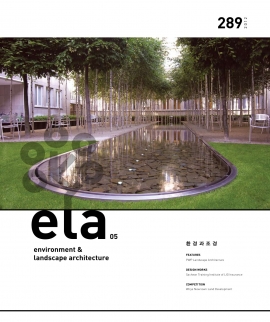Q1. PWP가 설립되던 1980년대, 조경 업계는 변화의 시기를 겪고 있었는데요. PWP는 이러한 전환기를 어떻게 지나왔는지요? 더불어 내년이면 설립 30주년을 맞는데, 지난 30년간 변화하지 않은 것은 무엇이며, 변화한 것은 무엇인지 궁금합니다.
피터 워커: 지난 30년간 변화하지 않은 것이라면 우리들의 철학이라 할 수 있겠지요. 우리는 항상 조경을 예술의 경지로 끌어올리는 데 관심을 기울여왔어요. 처음 회사를 만들 때도 그러했고, 지금도 여전히 많은 관심을 가지고 있습니다. 확실히 바뀐 점이 있다면, 회사가 많이 커졌다는 사실입니다. 우리는 여전히 작은 회사이긴 하지만, 예전에 비해 그 역량이 많이 커졌습니다. 규모가 작은 프로젝트라면 그것을 완성하는 것이 그리 복잡한 문제는 아닙니다. 하지만 Memorial처럼 수년이 걸리는 프로젝트라면 일을 제대로 끝마치는 것이 매우 복잡한 문제가 됩니다. 제 생각에는 이러한 복잡한 문제들을 해결하기 위해 우리 회사가 변화해온 것 같습니다. 하지만 그렇다고 우리가 노력을 기울이는 대상까지 달라진 것은 아니라고 생각합니다. 우리는 사람들에게 쓸모 있고, 아름다운 동시에 잘 만들어진, 지속가능한 조경공간을 만들기 위해 지금도 노력하고 있습니다. 회사가 설립된 이래로 그런 일을 할 수 있기를 늘 희망했습니다.
데이비드 워커: 특정 분야에서 이렇게 오랫동안 일을 하면서, 격정적 개발과 경제적 변화를 겪다 보면 흥미로운 일이 벌어집니다. 다시 말해 매우 다양한 실험을 해야 한다는 사실입니다. 또한 초창기 다양한 사람들이 회사를 거쳐 갔는데, 마샤 슈왈츠(Martha Schwartz), 켄 스미스(Ken Smith), 그리고 마타 프라이(Marta Frye) 등이 바로 그런 직원들이었습니다. 회사는 회사에 대한 소속감을 가진 사람들로 이뤄져 있으며, 회사의 동력과 디자인은 바로 거기에서 비롯되는 것입니다.
디자인상의 방법론에 있어서 우리가 이전보다 “타임리스(timeless)” 해졌다는 것이 제 생각입니다. 예를 들어 우리에게는 Novartis처럼 매우 중요한 클라이언트들이 있는데, 이러한 고객들은 얼마나 미니멀해질 수 있을까에 대해 우리가 갖고 있던 기존의 철학을 뛰어넘을 수 있을 만큼 커다란 자극을 주었습니다. 노타비스와의 작업은, 스위스 방식이 대개 그러하듯이, 매우 엄밀하게 이뤄졌기 때문에 디자인에 대한 우리의 생각에도 많은 변화가 있었습니다.
그쪽 사람들은 일부러 디자인된 것 같은 인상을 풍기는 부분들은 반드시 제거하려 들었습니다. 훨씬 더 시각적 성격이 강한 것들을 바탕으로 시간에 구속되지 않는, 이른바 타임리스한 경관을 만들라는 요구를 받았습니다. 이런 부분이 고객의 수준에 따라 나타나는 차이점 중 하나입니다. 일단 작업을 시작하고 나면, 세계 무역센터(World Trade Center)이든, 트랜스베이(Transbay)이든, 혹은 시드니(Sydney) 시당국이든, 우리는 클라이언트를 바라보며 일하지 않습니다.
Q1. The practice of landscape architecture has gone through transitions since the 1980 when PWP was founded. How do you see PWP’s journey through the transition? What has remained the same? What has changed? How will / should it change in the future?
Peter Walker: I think that what hasn’t changed over the last 30 years is our philosophy. We have always been a firm that has been interested in making landscapes at an artful level.
We were interested in that at the very beginning of the firm, and we’re still interested in that. What has changed, obviously, is we have become larger. We are more capable than we were, even though we’re still a small firm. But the projects themselves have become greater. When you’re working on small competitions, the problem of accomplishment is not very complicated. But if you’re working on something like the Memorial, where it goes over many, many years, the problems of getting it done are very complicated. And I think our firm has changed in order to satisfy these complications. But I don’t think that has changed what we are trying to do. We are still trying to make landscapes that are useful to people and are beautiful and well made and sustainable. We’ve been wanting to do that ever since we began.
David Walker: What’s interesting about a practice that’s lasted this long and gone through so many intense periods of development and economic change is that we got to experiment with a lot of different things. Additionally there were a lot of different members of the firm in the early days like Martha Schwartz, Ken Smith, and Marta Frye. A firm is really made up of the people who belong to it, and that’s where the energy and the design influence comes from.
I think we’ve become more “timeless” in our design approach. We’ve had some very important clients like Novartis, for instance, that really pushed us beyond our own philosophies of how minimal we can be. The work at Novartis was so precise in a very Swiss way that they challenged our own thoughts about design. They were always trying to eliminate the parts that looked like they were designed. They made us think about making timeless landscapes out of things that had a much more visible level of design. That’s one difference, the level of clientele. When we got started we were not working for clients of the caliber of the World Trade Center or Transbay or the government in Sydney.





